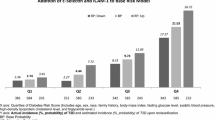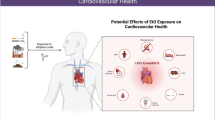Abstract
Ethylene oxide (EtO) is a highly reactive organic compound that is mainly used as a sterilizing agent. However, to date, the effects of EtO on the cardiovascular system are not clear. We aimed to explore the association between blood EtO levels and the risk of cardiovascular disease (CVD) in the general US population. We obtained information on blood levels of EtO and CVD outcomes in 3,410 participants from the National Health and Nutritional Examination Survey (NHANES) 2013–2014 and 2015–2016. Logistic regression models were applied to calculate the odds ratios (ORs) and 95% confidence intervals (95% CIs) for the association between EtO and risk of all CVD as well as subtypes of CVD. Linear regression analyses were used to estimate the associations of EtO with potential mechanistic parameters of CVD, including blood pressure, blood lipid levels and inflammatory parameters. Higher blood levels of EtO were associated with an increased risk of all CVD (p for trend = 0.003), with an adjusted OR (95% CI) in the highest quartile of 1.94 (1.24, 3.02) compared with the lowest quartile as a reference. Higher concentrations of EtO were positively associated with the risk of angina (p for trend = 0.04) and heart attack (p for trend = 0.011). In addition, the concentration of EtO was positively associated with the levels of triglycerides, white blood cells, lymphocytes, monocytes, neutrophils and eosinophils (p = 0.003 for eosinophils and p < 0.001 for the others) and negatively associated with the level of high-density lipoprotein cholesterol (p < 0.001). We found that exposure to EtO was associated with angina, heart attack and all CVD in a large representative US population. Furthermore, EtO may induce CVD through the inflammatory response and abnormal fatty acid metabolism.

Similar content being viewed by others
References
Alvarez CA, Lingvay I, Vuylsteke V, Koffarnus RL, McGuire DK (2015) Cardiovascular risk in diabetes mellitus: complication of the disease or of antihyperglycemic medications. Clin Pharmacol Ther 98:145–161
Amoroso L, Cocumelli C, Bruni G, Brozzi A, Tancredi F, Grifoni G, Mastromattei A, Meoli R, Di Guardo G, Eleni C (2017) Ethylene glycol toxicity: a retrospective pathological study in cats. Vet Ital 53:251–254
Andrews JE, Courtney KD, Donaldson WE (1983) The effects of ethylene chlorohydrin on fatty acid synthesis. J Environ Sci Health B 18:351–367
Bhatnagar A (2004) Cardiovascular pathophysiology of environmental pollutants. Am J Physiol Heart Circ Physiol 286:H479–H485
Bhatnagar A (2006) Environmental cardiology: studying mechanistic links between pollution and heart disease. Circ Res 99:692–705
Boyle EB, Viet SM, Wright DJ, Merrill LS, Alwis KU, Blount BC, Mortensen ME, Moye J Jr, Dellarco M (2016) Assessment of exposure to VOCs among pregnant women in the national children’s study. Int J Environ Res Public Health 13:376
Brucker N, Charao MF, Moro AM, Ferrari P, Bubols G, Sauer E, Fracasso R, Durgante J, Thiesen FV, Duarte MM, Gioda A, Castro I, Saldiva PH, Garcia SC (2014) Atherosclerotic process in taxi drivers occupationally exposed to air pollution and co-morbidities. Environ Res 131:31–38
Burstyn I, Kromhout H, Partanen T, Svane O, Langard S, Ahrens W, Kauppinen T, Stucker I, Shaham J, Heederik D, Ferro G, Heikkila P, Hooiveld M, Johansen C, Randem BG, Boffetta P (2005) Polycyclic aromatic hydrocarbons and fatal ischemic heart disease. Epidemiology 16:744–750
Calogero D, Buchen SY, Tarver ME, Hilmantel G, Lucas AD, Eydelman MB (2012) Evaluation of intraocular reactivity to metallic and ethylene oxide contaminants of medical devices in a rabbit model. Ophthalmology 119:e36–e42
Crouch M, Al-Shaer A, Shaikh SR (2020) Hormonal dysregulation and unbalanced specialized pro-resolving mediator biosynthesis contribute toward impaired B cell outcomes in obesity. Mol Nutr Food Res 65(1):e1900924
Dziechciaz M, Filip R (2014) Biological psychological and social determinants of old age: bio-psycho-social aspects of human aging. Ann Agric Environ Med 21:835–838
Elagizi A, Kachur S, Lavie CJ, Carbone S, Pandey A, Ortega FB, Milani RV (2018) An overview and update on obesity and the obesity paradox in cardiovascular diseases. Prog Cardiovasc Dis 61:142–150
Filser JG, Klein D (2018) A physiologically based toxicokinetic model for inhaled ethylene and ethylene oxide in mouse, rat, and human. Toxicol Lett 286:54–79
Gardner MJ, Coggon D, Pannett B, Harris EC (1989) Workers exposed to ethylene oxide: a follow up study. Br J Ind Med 46:860–865
Genkel VV, Shaposhnik II (2020) Conceptualization of heterogeneity of chronic diseases and atherosclerosis as a pathway to precision medicine: endophenotype, endotype, and residual cardiovascular risk. Int J Chronic Dis 2020:5950813
Goniewicz ML, Gawron M, Smith DM, Peng M, Jacob P 3rd, Benowitz NL (2017) Exposure to nicotine and selected toxicants in cigarette smokers who switched to electronic cigarettes: a longitudinal within-subjects observational study. Nicotine Tob Res 19:160–167
Greenfield DM, Snowden JA (2019): Cardiovascular diseases and metabolic syndrome. In: th, Carreras E, Dufour C, Mohty M, Kroger N (Editors), The EBMT handbook: hematopoietic stem cell transplantation and cellular therapies. Springer Copyright 2019, EBMT and the Author(s). Cham (CH), pp. 415–420
Hamad A, Iweala OI, Henderson C, Madan S, Stouffer GA 3rd, Commins SP, Kim EH (2018) Recurrent anaphylaxis during cardiac catheterization due to ethylene oxide. J Allergy Clin Immunol Pract 6:2148–2150
Hogstedt C, Malmqvist N, Wadman B (1979a) Leukemia in workers exposed to ethylene oxide. Jama 241:1132–1133
Hogstedt C, Rohlen O, Berndtsson BS, Axelson O, Ehrenberg L (1979b) A cohort study of mortality and cancer incidence in ethylene oxide production workers. Br J Ind Med 36:276–280
Huang M, Jiao J, Zhuang P, Chen X, Wang J, Zhang Y (2018) Serum polyfluoroalkyl chemicals are associated with risk of cardiovascular diseases in national US population. Environ Int 119:37–46
Jinot J, Fritz JM, Vulimiri SV, Keshava N (2018) Carcinogenicity of ethylene oxide: key findings and scientific issues. Toxicol Mech Methods 28:386–396
Kelly BB, Narula J, Fuster V (2012) Recognizing global burden of cardiovascular disease and related chronic diseases. Mt Sinai J Med 79:632–640
Kokubo Y, Matsumoto C (2017) Hypertension is a risk factor for several types of heart disease: review of prospective studies. Adv Exp Med Biol 956:419–426
Krishnan K, Gargas ML, Fennell TR, Andersen ME (1992) A physiologically based description of ethylene oxide dosimetry in the rat. Toxicol Ind Health 8:121–140
Lomas RJ, Gillan HL, Matthews JB, Ingham E, Kearney JN (2001) An evaluation of the capacity of differently prepared demineralised bone matrices (DBM) and toxic residuals of ethylene oxide (EtOx) to provoke an inflammatory response in vitro. Biomaterials 22:913–921
Marsh GM, Keeton KA, Riordan AS, Best EA, Benson SM (2019) Ethylene oxide and risk of lympho-hematopoietic cancer and breast cancer: a systematic literature review and meta-analysis. Int Arch Occup Environ Health 92:919–939
Mastin JP (2005) Environmental cardiovascular disease. Cardiovasc Toxicol 5:91–94
Mikoczy Z, Tinnerberg H, Bjork J, Albin M (2011) Cancer incidence and mortality in Swedish sterilant workers exposed to ethylene oxide: updated cohort study findings 1972-2006. Int J Environ Res Public Health 8:2009–2019
Mozaffarian D, Benjamin EJ, Go AS, Arnett DK, Blaha MJ, Cushman M, de Ferranti S, Després JP, Fullerton HJ, Howard VJ, Huffman MD, Judd SE, Kissela BM, Lackland DT, Lichtman JH, Lisabeth LD, Liu S, Mackey RH, Matchar DB, McGuire D, Mohler ER 3rd, Moy CS, Muntner P, Mussolino ME, Nasir K, Neumar RW, Nichol G, Palaniappan L, Pandey DK, Reeves MJ, Rodriguez CJ, Sorlie PD, Stein J, Towfighi A, Turan TN, Virani SS, Willey JZ, Woo D, Yeh RW, Turner MB, American Heart Association Statistics Committee and Stroke Statistics Subcommittee (2015) Heart disease and stroke statistics—2015 update: a report from the American Heart Association. Circulation 131:e29–e322
Nordestgaard BG, Varbo A (2014) Triglycerides and cardiovascular disease. Lancet 384:626–635
Olaguer EP, Robinson A, Kilmer S, Haywood J, Lehner D (2020) Ethylene oxide exposure attribution and emissions quantification based on ambient air measurements near a sterilization facility. Int J Environ Res Public Health 17:42
Pearson F, Bruszer G, Lee W, Sagona M, Sargent H, Woods E, Dolovich J, Caruana R (1987) Ethylene oxide sensitivity in hemodialysis patients. Artif Organs 11:100–103
Polifka JE, Rutledge JC, Kimmel GL, Dellarco V, Generoso WM (1996) Exposure to ethylene oxide during the early zygotic period induces skeletal anomalies in mouse fetuses. Teratology 53:1–9
Pottenger LH, Boysen G, Brown K, Cadet J, Fuchs RP, Johnson GE, Swenberg JA (2019) Understanding the importance of low-molecular weight (ethylene oxide- and propylene oxide-induced) DNA adducts and mutations in risk assessment: insights from 15 years of research and collaborative discussions. Environ Mol Mutagen 60:100–121
Rubinstein ML, Delucchi K, Benowitz NL, Ramo DE (2018) Adolescent exposure to toxic volatile organic chemicals from E-cigarettes. Pediatrics 141:e20173557
Shintani H (2017) Ethylene oxide gas sterilization of medical devices. Biocontrol Sci 22:1–16
St Helen G, Jacob P 3rd, Peng M, Dempsey DA, Hammond SK, Benowitz NL (2014) Intake of toxic and carcinogenic volatile organic compounds from secondhand smoke in motor vehicles. Cancer Epidemiol Biomark Prev 23:2774–2782
Steenland K, Whelan E, Deddens J, Stayner L, Ward E (2003) Ethylene oxide and breast cancer incidence in a cohort study of 7576 women (United States). Cancer Causes Control 14:531–539
Steenland K, Stayner L, Deddens J (2004) Mortality analyses in a cohort of 18 235 ethylene oxide exposed workers: follow up extended from 1987 to 1998. Occup Environ Med 61:2–7
Swaen GM, Burns C, Teta JM, Bodner K, Keenan D, Bodnar CM (2009) Mortality study update of ethylene oxide workers in chemical manufacturing: a 15 year update. J Occup Environ Med 51:714–723
Teta MJ, Benson LO, Vitale JN (1993) Mortality study of ethylene oxide workers in chemical manufacturing: a 10 year update. Br J Ind Med 50:704–709
Vincent MJ, Kozal JS, Thompson WJ, Maier A, Dotson GS, Best EA, Mundt KA (2019) Ethylene oxide: cancer evidence integration and dose-response implications. Dose-Response 17:1559325819888317
Zhang Y, Huang M, Zhuang P, Jiao J, Chen X, Wang J, Wu Y (2018) Exposure to acrylamide and the risk of cardiovascular diseases in the National Health and Nutrition Examination Survey 2003–2006. Environ Int 117:154–163
Availability of data and materials
The datasets used and analysed during the current study are available from https://www.cdc.gov/nchs/nhanes/nhanes_questionnaires.htm.
Funding
This work was supported by funding from the Medical Science and Technology Development Foundation, Jiangsu Provincial Commission of Health and Family Planning (grant no. ZDRCA2016073) and Key Project of the Jiangsu Commission of Health (ZDA2020004).
Author information
Authors and Affiliations
Contributions
K.H.W.: conceptualization, methodology. Q.Z.: data curation, project administration. Q.Z.: writing—original draft preparation and editing. G.W.Z. and K.H.W.: supervision, investigation. X.W.W.: validation. G.W.Z. and K.H.W.: writing—review and editing.
Corresponding author
Ethics declarations
Ethics approval and consent to participate
The consent form was signed by the survey participants, and the participants consented to storing specimens of their blood for future research. The CDC/NCHS Ethics Review Board approved the NHANES study and gave approval for public dissemination.
Consent for publication
Not applicable. There is no individual-level data in our publication.
Competing interests
The authors declare no competing interests.
Additional information
Responsible Editor: Lotfi Aleya
Publisher’s note
Springer Nature remains neutral with regard to jurisdictional claims in published maps and institutional affiliations.
Rights and permissions
About this article
Cite this article
Zeng, G., Zhang, Q., Wang, X. et al. Association between blood ethylene oxide levels and the risk of cardiovascular diseases in the general population. Environ Sci Pollut Res 28, 64921–64928 (2021). https://doi.org/10.1007/s11356-021-15572-0
Received:
Accepted:
Published:
Issue Date:
DOI: https://doi.org/10.1007/s11356-021-15572-0




